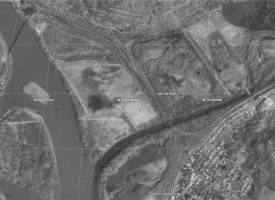jar546
CBO
"The Junction," also known as "the Flats," in Pittston, PA, holds a special place in my heart because it's where I come from and where my father and other family members worked on the railroad. This area, rich in railroad history, was closely tied to the Delaware, Lackawanna & Western Railroad (DL&W) and the Lehigh Valley Railroad. Located along the Susquehanna River, the flat, expansive terrain made it an ideal spot for a railyard. The Junction became a crucial hub where trains from various lines converged. The DL&W played a vital role in transporting anthracite coal from Northeastern Pennsylvania to markets in New York and New Jersey, with the Junction serving as a key interchange point. The Lehigh Valley Railroad also utilized the Junction for switching and assembling trains. This railyard was a hive of activity, handling operations like switching railcars, assembling new trains, and managing freight traffic. It also housed facilities for maintaining and repairing locomotives and railcars, ensuring everything ran smoothly.
Nearby, Coxton Yards, primarily operated by the Lehigh Valley Railroad, was another significant rail yard. Coxton Yards served as a major freight hub where railcars were sorted, assembled into trains, and dispatched to various destinations. It played a crucial role in transporting anthracite coal and other goods, bolstering the local economy. While the Junction was mainly a switching and interchange point, Coxton Yards had extensive facilities for maintenance and repair, ensuring the rail network operated efficiently. Both Coxton Yards and the Junction were geographically close and integral parts of the rail infrastructure in Pittston, each playing a vital role in the region's railroading history.
The presence of these rail hubs significantly impacted Pittston's economy, providing jobs for many residents, including my family, in roles like brakemen, engineers, and conductors. The economic activity generated by the railroads spurred the growth of local industries such as coal mining, manufacturing, and retail. However, by the mid-20th century, the decline of the anthracite coal industry and the rise of alternative transportation methods led to reduced rail traffic through both the Junction and Coxton Yards. Despite this decline, the historical significance of these areas remains an important part of Pittston's heritage. Today, efforts to preserve the region's history, including its railroading past, are evident in local historical societies and community initiatives. The legacy of the Junction and Coxton Yards continues, reflecting the broader story of Northeastern Pennsylvania's industrial and economic development, showcasing railroads' pivotal role in the region's growth and prosperity.

Nearby, Coxton Yards, primarily operated by the Lehigh Valley Railroad, was another significant rail yard. Coxton Yards served as a major freight hub where railcars were sorted, assembled into trains, and dispatched to various destinations. It played a crucial role in transporting anthracite coal and other goods, bolstering the local economy. While the Junction was mainly a switching and interchange point, Coxton Yards had extensive facilities for maintenance and repair, ensuring the rail network operated efficiently. Both Coxton Yards and the Junction were geographically close and integral parts of the rail infrastructure in Pittston, each playing a vital role in the region's railroading history.
The presence of these rail hubs significantly impacted Pittston's economy, providing jobs for many residents, including my family, in roles like brakemen, engineers, and conductors. The economic activity generated by the railroads spurred the growth of local industries such as coal mining, manufacturing, and retail. However, by the mid-20th century, the decline of the anthracite coal industry and the rise of alternative transportation methods led to reduced rail traffic through both the Junction and Coxton Yards. Despite this decline, the historical significance of these areas remains an important part of Pittston's heritage. Today, efforts to preserve the region's history, including its railroading past, are evident in local historical societies and community initiatives. The legacy of the Junction and Coxton Yards continues, reflecting the broader story of Northeastern Pennsylvania's industrial and economic development, showcasing railroads' pivotal role in the region's growth and prosperity.

